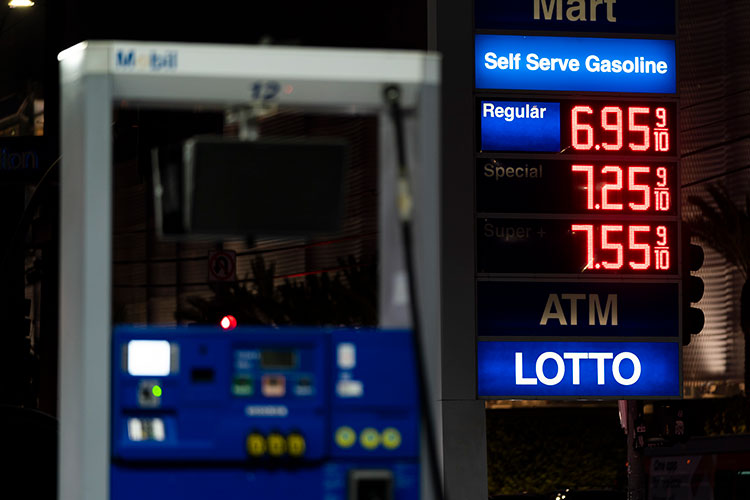Russia’s attack: Ukraine war turns into a perilous global economic conflict
The war's endgame might hinge on which side — Russia or the West — can endure the most economic pain, Berkeley scholars say.
March 11, 2022

Gas prices had been rising steadily as the pandemic eased and the U.S. economy came back to life. But when Russia invaded Ukraine, oil supplies were weaponized — and prices have soared to their highest real levels since 2008. (Photo by Jae C. Hong/AP)
The cameras are focused on the savage Russian bombardment of Ukraine and the resistance of Ukrainians and Russian protesters, but largely off-camera, the war is unfolding as a rapidly escalating economic conflict that has sent shock waves around the world.
In Russia, Western sanctions have cut off most access to the international systems of banking and trade. The ruble has lost 40% of its value, and that has demolished the value of savings for oligarchs and ordinary people and set fire to inflation. The country is on the verge of default.

M. Steven Fish (UC Berkeley photo)
In countries allied against Russia and worldwide, gasoline prices are soaring — and that was before U.S. President Joe Biden on Tuesday announced an embargo of Russian oil. Western oil companies and other businesses have walked away from tens of billions of dollars in Russian investment and trade. Inflation worries are reaching fever level.
While Ukrainian forces are achieving remarkable successes against the invading Russian army, UC Berkeley scholars in a series of interviews said the war’s outcome may also depend on the outcome of an economic conflict that will impose enormous costs on all sides.
“The endgame does hinge, or might hinge, on who can endure the most economic pain,” said political scientist M. Steven Fish, a Berkeley Russia expert. “Putin and his elite are going to suffer much more economic pain than we will, even if we end up paying a higher economic cost than we expected. The question is whether we’re actually willing to bear that pain.”

Donald Hanna (Photo by Diana Daymond)
How much pain? Donald Hanna, an economist at Berkeley Haas, cited a recent Oxford Economics forecast that sanctions, embargoes and other disruptions associated with the war could slash the world’s expected economic growth by 15% this year and by 33% if the war continues in 2023. That’s hundreds of billions of dollars lost to businesses, governments, communities and families worldwide.
“We’re about to find out how different parts of the world value having a more open, democratic political structure — because there’s a cost to bear for this now,” Hanna said. “The cost is going to be larger and more apparent than it was in the past.”
The devastating new forms of economic warfare
Economic warfare dates far back into history, but took its modern form during the First World War. Great Britain, France and the U.S. worked to weaken Germany’s military machine by confiscating German goods at sea, blocking its access to credit and disrupting its supply chains. Before WWII, the U.S. imposed crippling economic sanctions on Japan.
But the world has grown smaller, and in the 21st century, even hostile nations are interdependent, held closely together by trade in energy and food, and by banking and digital networks.
In that environment, Putin’s Russia appears to be at a monumental disadvantage: The U.S. annual gross domestic product is $21 trillion, compared to just under $1.5 trillion for Russia. Germany, Italy, France, Japan and Canada — even the U.S. states of California and Texas — have economies bigger than Russia’s.

Russian President Vladimir Putin launched the invasion of neighboring Ukraine, but Berkeley scholars say he may have underestimated the willingness of governments in Europe, North America and the Asia Pacific region — and their people — to accept economic sacrifices in its defense. (Photo by www.kremlin.ru/Wikimedia Commons)
Russia is also the world’s third largest oil producer, and Putin almost certainly assessed the apparent economic vulnerability in his adversaries. The public in Europe, the U.S. and other countries is weary after struggling through the COVID pandemic for two years and being increasingly stressed by inflation. Nearly 40% of the gas used to heat European homes comes from Russia, and winter isn’t over yet.
“It certainly seemed to help Putin that Western Europe is so dependent on Russian gas and oil that they don’t dare to cut their ties,” said Berkeley economist Yuriy Gorodnichenko, a Ukrainian with family still in that country.
“Putin knows the limits of his own economic leverage,” explained Fish. “But he sees democracies as really soft, and he sees people in Western societies as so dispirited, so lacking in hard-core patriotism, that they don’t have any capacity for suffering.
“He might have thought that they would be unwilling to put up with another dime or a quarter at the gas pump.”
For all sides, the costs of war are spiraling

Yuriy Gorodnichenko (UC Berkeley photo)
Putin may be surprised at the fervor with which Western countries and their people have come together militarily, politically and economically to support Ukraine and impose crushing costs on Russia.
At the same time, Europe, the U.S. and allied countries have employed economic weapons at a scale and severity unprecedented in modern history. Almost overnight, they’ve cut Russia’s connections to the global economic system, leaving it economically isolated and nearly paralyzed. The repercussions have been profound.
The ruble continues to slide. Fearing panic, the Russian stock market has been closed since just after the invasion two weeks ago. The Western allies have tied up hundreds of billions of dollars in overseas assets held by Russian oligarchs, including Putin, and denied access to funds that would have been used to support the war against Ukraine. Hoping to prevent further losses, Russia has put restrictions on the financial activities of its people.
To be sure, Western interests are also feeling intense pressure. In the days after the Russian invasion of Ukraine, Germany walked away from the Nord Stream 2 pipeline that was to double its supply of Russian natural gas and ease price pressure on its consumers. European businesses that had significant financial stakes in Russia have lost tens of billions of dollars in market value.
In the United States, average gasoline prices have soared past $4 a gallon and continue to rise to their highest real levels since 2008 — signaling higher consumer prices for food and transportation. Oil companies have walked away from billions of dollars in Russian investments, and companies such as Starbucks and Nike have closed operations in Russia. Financial institutions that hold Russian debt can’t be paid.
The war comes with another cost: the need to invest more in military defense. Germany alone has pledged to add $100 billion a year to its defense spending.
The end of the Cold War 30 years ago brought a peace dividend to much of Europe and North America, “but it’s very clear this peace dividend is gone,” said Gorodnichenko. “You have to spend on defense. There will be an arms race. There is no question about that.”
That likely means higher taxes, reduced government investment in other areas, and reduced consumer spending.
On gas prices, we haven’t seen the worst

The cost of OPEC oil was just over $70 a barrel in late December, but as Russia pressed its attack on Ukraine, the price this week rose to $128. By some estimates it could hit $150 if the conflict continues. (Graphic by Neil Freese/UC Berkeley)
While the economic war has many dimensions, for Western consumers it is most visible — and seemingly most painful — in the price of gasoline. As the war continues, oil will remain a crucial weapon.
Oil companies had sharply cut production during the pandemic, but as the world recovered, oil production did not. Prices were already rising, and when Russia invaded Ukraine, pressure on oil prices spiked. The cost of a barrel of OPEC oil was just over $70 a barrel in late December, but this week rose to $128 — and by some estimates it could hit $150 if the conflict continues.

Severin Borenstein (Photo by Jim Block)
It’s counterintuitive, but global oil supplies have not yet been severely affected by the war, said Severin Borenstein, faculty director of the Energy Institute at Berkeley Haas. Other war-related factors, however, are combining to drive up prices.
With supplies uncertain, Borenstein said, oil traders have factored the risk of future disruptions into near-term prices. When the U.S. banned the import of Russian oil and gas this week, he explained, the effect was “mostly symbolic” — the U.S. gets only a small portion of its oil from Russia. Still, he said, that could press prices still higher if a wider boycott of Russian oil follows and Russia can’t get its crude into the world market..
In Hanna’s view, that presents a risk for the near future. Rising prices could reduce economic activity, resulting in both inflation and unemployment.
If the war were to end soon, those pressures would fade quickly, the Berkeley experts suggested.
But what if, instead, the war escalates? What if Russia cuts off oil and gas supplies to its adversaries? Or suppose the allies take action to shut down Russia’s ability to sell its oil and gas?
Some analysts have projected that oil could rise to $200 a barrel. Borenstein thinks that unlikely, but he can envision worst-case scenarios that lead to staggering costs.

Thousands of miles from the fighting in Ukraine, the oil and gas produced in the Russian tundra at the Zapolyarnoye gas field are critical factors in the economic warfare between Russia and allied governments stretching from Europe to the Americas and Australia. (Photo by Russian Federation Government/Wikipedia)
If the U.S. and Europe move to completely block Russia’s oil trade, he said, “that would cripple Russia’s economy, but it would have a very big effect on oil prices here. … That would be a very aggressive move, and both the Biden administration and our allies are worried that could instigate a broader war.”
Instead, he suggested, Biden and allied countries are trying to thread a needle, using oil and gas to impose substantial, but limited, costs on Russia while limiting the negative impact on their own consumers.
Borenstein offers a note of cautious optimism: The futures market, where commodity traders speculate on the future price of oil, currently peg the prices a year from now at $20 to $30 per barrel lower than current prices.
The moral calculation: How much sacrifice to support freedom?

Anastassia Fedyk (Photo by Noah Berger)
Economics can seem a dry science, a passionless way to assess gain and loss or to understand money-related behavior of businesses or individuals. But in real life, there are often ethical and moral dimensions to economic calculations, and in assessing the war against Ukraine and the world’s response, those dimensions are pronounced.
In terms of energy, Berkeley experts suggested that the war, and the intense risks associated with our dependence on fossil fuels, could lead more businesses and more people toward energy efficiency and green energy.
In terms of trade and finance, one of the most profound costs will be trust, Gorodnichenko said. “It’s very clear right now that Russia is not a reliable trading partner,” he said. “That will be very hard to repair. … If you can’t trust, you can’t trade.”
But evaluating the costs of an economic war requires a consideration of the moral values that provide a foundation for liberal democracy, said Ukrainian scholar Anastassia Fedyk, an assistant professor of finance at Berkeley Haas.
“We stand before a clear choice,” Fedyk said. “We can accept temporary surges in prices, or we actively abet the destruction of a sovereign nation and allow Putin to amass more power for his next move.”
If we decide that gasoline prices are too high or lost business opportunities are too valuable, she added, “future generations will damn our inaction, or insufficient action, much like we condemn slave owners who chose economic comfort over moral rectitude and human dignity.”
Fish, too, said the human costs of this war must be considered the highest value.
“The Ukrainian people are the front lines in this,” he said. “They are paying the highest price in human lives and economic destruction by a factor of a thousand, compared to all the rest of us. The least we can do is to use every economic means at our disposal to help them save democracy and save the world from Putin. That’s what it comes down to.”